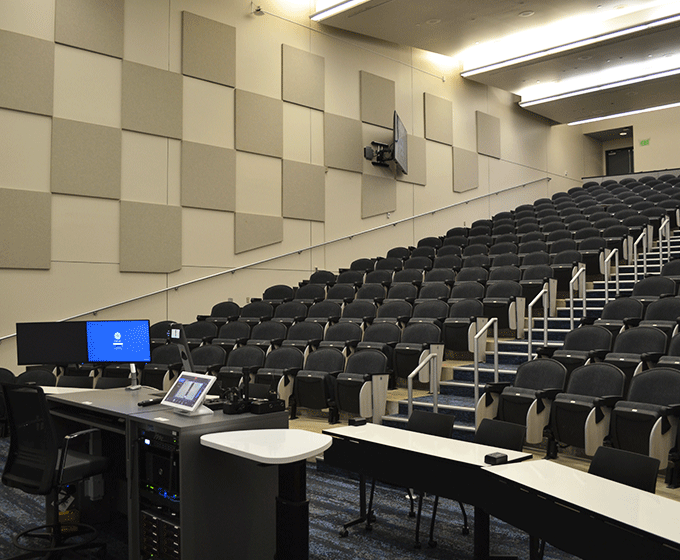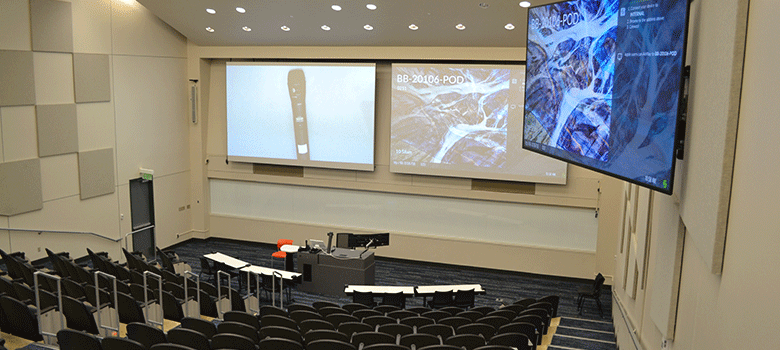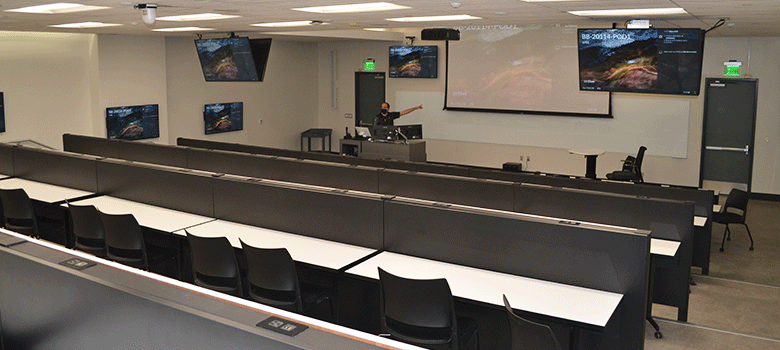
SEPTEMBER 9, 2021 — Editor’s note: This story is the second in a four-part series highlighting the new Academic Success District. Read the first article in the series here; Part three will highlight the new Academic Innovation center designed to support innovative instructional practices and promote collaborative learning between faculty and students; Part four will summarize the key components of the Academic Success District.
When Roadrunners return to campus this semester, they'll find exciting new upgrades to nearly two dozen classrooms across Main Campus. The upgrades demonstrate UTSA’s commitment to investing in, reinventing and reinvigorating its physical spaces and instructional technology, helping students build bold futures.

Through integrated technology, BB 02.01.06 in the Business Building has been updated to serve as an "Active-Connected" classroom.
Academic Affairs, Business Affairs and University Technology Solutions collaborated to create inclusive, innovative and accessible environments for the Roadrunner community. UTSA designed these spaces after engaging students and faculty through surveys and in close consultation with faculty and student organizations. UTSA also examined larger, long-term trends in education and created its own dynamic vision of the future of classrooms.
Business Affairs and Academic Innovation, a division of Academic Affairs, surveyed classrooms in 11 buildings to identify spaces with the greatest need for improvements. A project committee, which included members of senior leadership, then met to review the scope of the project, ensuring the upgrades would be the most beneficial for students.
“We approached classroom upgrades strategically. To identify renovation needs, we conducted an evaluation of all our campus classrooms to rate the condition of their technology, furniture, flooring, paint, HVAC and lighting,” said Veronica Salazar Mendez, chief financial officer and senior vice president for business affairs. “We also conducted an interactive survey with students to understand their furniture preferences and needs to ensure we provide an optimal classroom experience.”
The interactive furniture survey allowed students to sample different furniture designs in-person and then provide their feedback. The primary objective in furniture selection was to provide comfort and flexibility in an active learning environment. Where possible, the new furniture can be quickly and easily reconfigured to support a wide variety of learning and studying styles, from the traditional lecture style to pairs or small group work.
Academic Innovation also led focus groups with faculty and students to learn more about their specific needs. The conversations helped the UTSA team better understand what was important to students and faculty respectively when it came learning and teaching in a classroom environment. As a result of its outreach and feedback process, Academic Innovation prioritized technology solutions and designed support programs.

These conversations, in part, helped fine-tune the plans for the four classroom personas: Core, Connected, Active-Connected and Cisco Unified classrooms. During Academic Innovation’s focus groups, faculty shared the importance of having a consistent experience from classroom to classroom, the desire to have guest speakers join remotely and the need to ensure that the technology supports their pedagogies. The classroom personas provide a variety of digital integrations within the physical space and allow faculty and students to use remote tools and rearrange classrooms to better suit their learning needs. Students will also have the ability to participate in the live classroom experience from a remote location.
“We are excited to see how these classrooms are used by students and faculty,” said Melissa Vito, vice provost for academic innovation. “These upgrades are an opportunity to continue experimenting with how the intersection of learning in a physical and digital space can help our students succeed at UTSA and in their future endeavors.”
The personas reinforce UTSA’s growing focus on digital accessibility and functionality for all students, helping students thrive on their academic journeys and allowing faculty to provide an inclusive and equitable learning experience. Classroom updates will be standardized so that all Roadrunners know how to use the integrated technology to their advantage. The updates will also help the university accommodate new learning styles in the future.
"UTSA has made important investments that support our faculty's ability to innovate in the classroom by providing collaborative digital tools and training," says UTSA Provost and Senior Vice President for Academic Affairs Kimberly Andrews Espy. "These classroom upgrades will facilitate faculty efforts to further incorporate innovative teaching practices into their classes and put our Roadrunners in high-quality learning environments that deepen student learning."
The combination of technology and in-person instruction encourages and cultivates digital literacy and soft-skill development through the use of UTSA-provided tools. One notable example of students’ digital development is the Defining Moments interdisciplinary project. This project encouraged the use of the Adobe Creative Suite, which students, faculty and staff have free access to given UTSA’s designation as an Adobe Creative Campus.
These renovations and improvements are possible thanks to federal funding from the Higher Education Emergency Relief Fund (HEERF). Approximately $103.3 million of UTSA’s $176.4 total HEERF funding has been allocated for institutional support, which includes ongoing strategic initiatives to improve the Roadrunner learning environment.
In September 2020, Academic Affairs announced the Academic Success District Initiative as an opportunity to more effectively utilize campus space in a manner that advances institutional objectives for student success and faculty excellence. Led by Espy and Senior Director of Space Management Joshua Gerken, divisions within Academic Affairs and Business Affairs—including Academic Innovation, Student Success, Space Management and Facilities—worked collaboratively with faculty and students to identify and design the spaces, share resources, and move the Academic Success District from concept to completion.
UTSA Today is produced by University Communications and Marketing, the official news source of The University of Texas at San Antonio. Send your feedback to news@utsa.edu. Keep up-to-date on UTSA news by visiting UTSA Today. Connect with UTSA online at Facebook, Twitter, Youtube and Instagram.
Huddle Against Hunger is a fundraising competition with Texas State that benefits our Roadrunner Pantry. Donations this week will help UTSA earn additional prize monies provided by RBFCU.
In-Person and VirtualJoin UTSA Libraries for an update on federal public access policies and how the library can assist with compliance.
Virtual EventWe invite you to join us for Birds Up! Downtown, an exciting welcome back event designed to connect students with the different departments at the Downtown Campus. Students will have the opportunity to learn about some of the departments on campus, gain access to different resources, and collect some giveaways!
Bill Miller PlazaThere are many citation managers. Which one is right for you? This workshop will explain what a citation manager is and how it can help you organize your citations, insert citations as you write your paper, and generate your bibliography.
Virtual EventPubMed is an essential database for anyone conducting biomedical or health-related research. This workshop will teach attendees how to effectively navigate this free resource and locate peer-reviewed articles using advanced search features, MeSH subject headings, and Boolean operators.
Virtual EventIn this hands-on workshop, participants will learn to setup an EndNote library, save references and PDFs, and automatically create and edit a bibliography. Attendees are encouraged, but not required, to have EndNote already installed on a personal computer.
Virtual EventJoin UTSA Libraries and Museums to learn more about the publishing discounts available for UTSA researchers. Current agreements include Elsevier, Cambridge University Press, Wiley, and more. Bring your questions and feedback for the library as we continue to pursue partnerships with publishers to reduce costs for our researchers.
Virtual EventThe University of Texas at San Antonio is dedicated to the advancement of knowledge through research and discovery, teaching and learning, community engagement and public service. As an institution of access and excellence, UTSA embraces multicultural traditions and serves as a center for intellectual and creative resources as well as a catalyst for socioeconomic development and the commercialization of intellectual property - for Texas, the nation and the world.
To be a premier public research university, providing access to educational excellence and preparing citizen leaders for the global environment.
We encourage an environment of dialogue and discovery, where integrity, excellence, respect, collaboration and innovation are fostered.